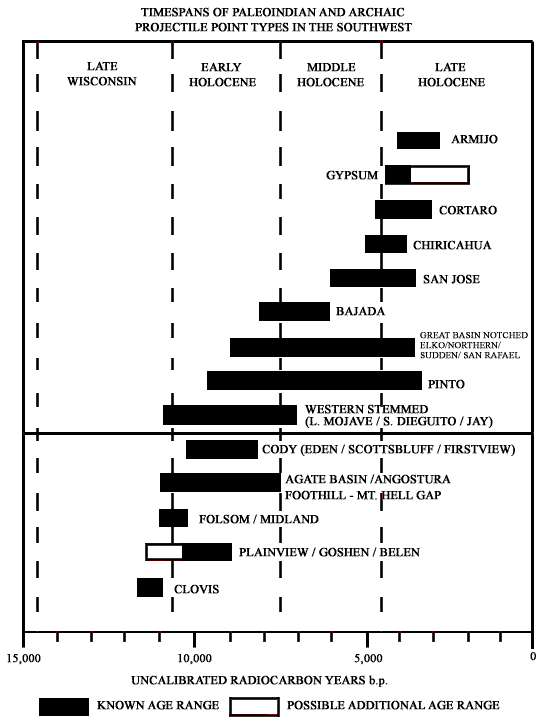Jonathan B. Mabry, Desert Archaeology, Inc.

Although they are referred to by a variety of names, Paleoindian projectile points in the Southwest can be grouped into five general types based on the ways they were made and their resulting forms. In the order of their uncalibrated radiocarbon age ranges, these include: 1) Clovis (11,600–10,900 b.p.); 2) Plainview/Goshen/Belen (11,300–9000 b.p.); 3) Folsom/Midland (10,900–10,200 b.p.); 4) Agate Basin/Angostura/Foothill-Mountain/Hell Gap (10,800–7500 b.p.); and 5) Eden/Scottsbluff/Firstview (sometimes grouped under the name “Cody”; 10,200–8200 b.p.).
Other than Clovis, which is found throughout North America, these are point types whose greatest concentrations are found in the Plains. At excavated sites in the Southwest and Plains, Paleoindian points are often found with bones of extinct megafauna, in associations indicating that they were used for hunting and butchering big game. For archaeologists, these and other projectile point types are useful as markers of distinct “complexes”—unique sets of artifact and feature types thought to represent different subsistence adaptations, technological traditions, and cultures.
Several varieties of large, tapering-stemmed points found in the Great Basin and Southwest, and dated between about 10,700 and 7000 b.p., are sometimes lumped with Paleoindian points. Referred to by various names (such as Lake Mojave, Silver Lake, San Dieguito, Ventana-Amargosa I, and Jay in the Southwest), they are often grouped under the name Western Stemmed or Great Basin Stemmed. Because stone seed grinding tools, cooking stones, and remains of a variety of edible plants and small animals have been found at some excavated sites with Western Stemmed points, many archaeologists think these points were used by “Early Archaic” peoples with more generalized hunting and gathering economies adapted to the new environmental conditions of the early Holocene.